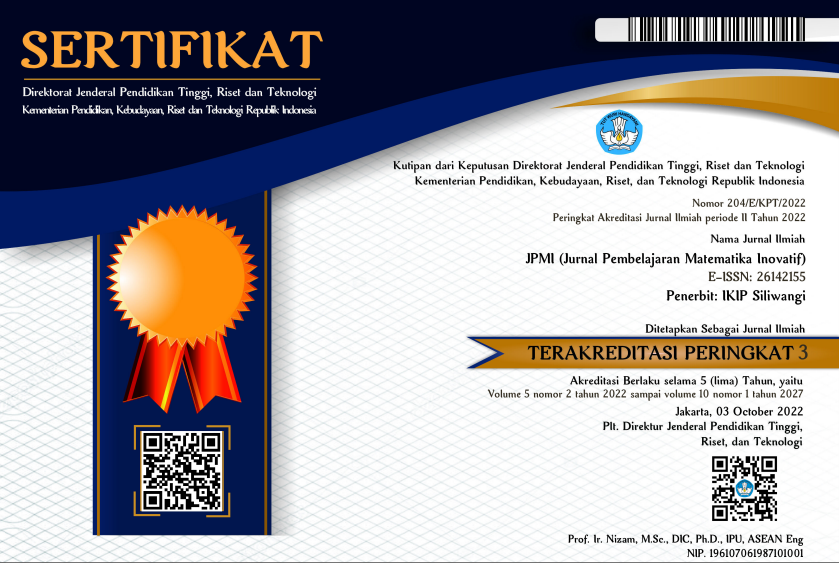UPAYA MENINGKATKAN MINAT BELAJAR MATEMATIKA MENGGUNAKAN MEDIA INTERAKTIF BERBASIS POWERPOINT
DOI:
https://doi.org/10.22460/jpmi.v5i1.p%25pKeywords:
Interest in Learning, Powerpoint-Based Interactive MediaAbstract
References
Apriani, N., Sutiarso, S., Rosidin FKIP Universitas Lampung, U., Soemantri Brojonegoro No, J., & Lampung, B. (n.d.). Jurnal Pendidikan Matematika Universitas Lampung Pengembangan Multimedia Interaktif PowerPoint dalam Pendekatan Saintifik untuk Meningkatkan Kemampuan Pemahaman Konsep Statistika. Retrieved from http://jurnal.fkip.unila.ac.id/index.php/MTK
Arsyad. (2014). Media Pembelajaran. Jakarta: Raja Grafindo Persada.
Dewi, M. D., & Izzati, N. (2020). Pengembangan Media Pembelajaran PowerPoint Interaktif Berbasis RME Materi Aljabar Kelas VII SMP. Delta: Jurnal Ilmiah Pendidikan Matematika, 8(2), 217. doi: 10.31941/delta.v8i2.1039
Dikbud, B., & Tokyo, K. (n.d.). UNDANG-UNDANG SISTEM PENDIDIKAN NASIONAL 1. UNDANG-UNDANG REPUBLIK INDONESIA NOMOR 20 TAHUN 2003 TENTANG SISTEM PENDIDIKAN NASIONAL DENGAN RAHMAT TUHAN YANG MAHA ESA PRESIDEN REPUBLIK INDONESIA.
Djamarah, S. . (2012). Prestasi Belajar Dan Kompetensi Guru. Surabaya: Usaha Nasional.
Hendriana, H. dan Afrilianto, M. (2017). Penelitian Tindakan Kelas. Bandung: Aditama.
Hutabarat, R. H., Hidayat, A., & Sritumin, B. A. (2017). Efektivitas Multimedia Interaktif Berbasis Power Point Untuk Meningkatkan Minat Belajar Siswa. In Jurbal JP2EA (Vol. 2, Issue 2, pp. 12–21).
Khaerunnisa, F., Sunarjan, Y., & Atmaja, H. T. (2018). The Effect of Using Power Point Media on the Interest in Learning History of Class X Students of SMA Negeri 1 Bumiayu for the 2017/2018 Academic Year. Indonesian Journal of History Education, 6(1), 31–41.
Komunikasi, J., Soraya, I., & Timur, J. (2007). Faktor-Faktor Yang Mempengaruhi Minat Nasabah. Jurnal Akuntansi Dan Keuangan, 9(1), 18–28. doi: 10.9744/jak.9.1.pp.18-28
Maemunawati, S., & Alif, M. (n.d.). “Peran Guru, Orang Tua, Metode dan Media Pembelajaran: Strategi KBM di Masa Pandemi Covid-19†Penerbit 3M Media Karya 2020.
Sugiyono. (2017). Metode Penelitian Pendidikan Pendekatan Kuantitatif, Kualitatif, dan R&D. Bandung. Bandung: Alfabeta.
Wulandari, S. (2020). Media Pembelajaran Interaktif Untuk Meningkatkan Minat Siswa Belajar Matematika Di SMP 1 Bukit Sundi. Indonesian Journal of Technology, Informatics and Science (IJTIS), 1(2), 43–48. doi: 10.24176/ijtis.v1i2.4891
Yung, K. (2011). 350 Profesional & Easy Steps PowerPoint. Jakarta: PT Elex Media Komputindo
Downloads
Published
Issue
Section
License
Copyright (c) 2022 JPMI (Jurnal Pembelajaran Matematika Inovatif)

This work is licensed under a Creative Commons Attribution-ShareAlike 4.0 International License.
The author is responsible for acquiring the permission(s) to reproduce any copyrighted figures, tables, data, or text that are being used in the submitted paper. Authors should note that text quotations of more than 250 words from a published or copyrighted work will require grant of permission from the original publisher to reprint. The written permission letter(s) must be submitted together with the manuscript.
















